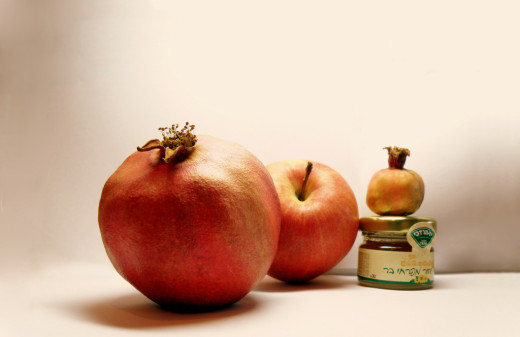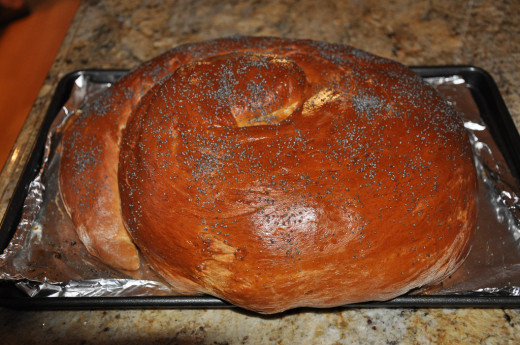Rosh Hashanah Food | Menu Ideas
When September rolls around each year, my ears are filled with the oh-so-melodious strains of a hundred preschoolers singing the classic song "Apples and Honey." (Yes, it's a reworking of the Macarena. Pretty cute, huh?) This year it set me to wondering about traditional foods for the high holiday season.
The Jewish high holidays fall in September every year, and comprise Rosh Hashanah and Yom Kippur. They are holidays that are in turn solemn and joyous, as we search our souls and atone for the wrongs we have done, and also celebrate the sweetness of a new year in which to start fresh.

Foods Associated with Rosh Hashanah
There are several traditional foods for Rosh Hashanah. The most common one is the pairing of apples with honey. This sweet treat is symbolic of our wish for a sweet new year. Other traditional foods include:
- Round challah: During the year, challahs are usually braided in a straight row. For the high holidays, however, we make the challahs round to symbolize the cycle of the year. Another explanation is that a round challah is like a crown, and one of the themes of Rosh Hashanah is God's sovereignty.
- Carrot coins: These symbolize prosperity in the year to come.
- Fish heads: Although not as common now, some people used to eat fish heads on Rosh Hashanah because the name of the holiday literally translates to "the head of the year".
- A new fruit: This can be any fruit that you haven't eaten in a long time, or it can be an exotic fruit that you've never tried before. The purpose of this is to allow you to say the Shehechiyanu blessing on the second day of the holiday. (The Shehechiyanu is said to celebrate something new, and thanks God for allowing us to reach the occasion.)
Those foods are all traditional for Ashkenazi Jews (with roots in Germany and Eastern Europe), but Sephardi Jews (descended from the Jews of Spain) have their own traditional foods for the new year.
- Pomegranates: Legend has it that there are 613 seeds in a pomegranate, the same as the number of commandments in the Torah.
- Foods whose symbolic meanings are based on wordplay: For instance, the word for beets sounds similar to the word meaning "to depart," so Sephardic Jews eat beets on Rosh Hashanah and say a prayer that their enemies should go away in the new year.
Traditional Rosh Hashanah Menu Ideas
Ashkenazi Jewish cooking tends to be heavy, filling, and laden with cholesterol. But if you're healthy enough and eat in moderation, the food is delicious. Here are some options for traditional dishes to serve at your Rosh Hashanah meals.
Common Main Dishes
| Side Dishes
| Desserts
|
|---|---|---|
brisket (braised or roasted)
| tzimmes (a sweet mix of carrots, sweet potatoes, white potatoes, prunes, and honey)
| honey cake
|
turkey
| honeyed carrots
| apple cake
|
baked or roasted chicken
| noodle kugel (sweet or savory, made with lots of eggs)
| tagelach (a honey-covered pyramid of dough balls, nuts, and fruit)
|
chicken soup
|

How to Incorporate Traditional Foods into Non-Traditional Rosh Hashanah Meals
What if you're not interested in eating heavy, traditional meals for Rosh Hashanah, but you'd still like to honor your culinary heritage? Take some of the symbolic foods of the holiday, and use them to make creative, lighter meals that are a better fit for your palate.
- If you prefer fish to meat, grill tuna steaks with a honey-based sauce for a touch of sweetness in your main dish. Or try making a fresh mango salsa and serving it over baked tilapia or halibut — you'll still be using fresh, fruity flavors for a sweet new year.
- For healthier side dishes, cut out the heavy egg- and margarine-based kugels and use fresh vegetables and whole grains. A pomegranate-quinoa salad is a healthful accompaniment to nearly any main dish. For people who miss tzimmes, try roasting carrots, potatoes, and sweet potatoes. Drizzle a touch of honey and lemon juice over the finished product just before serving.
- If you're a vegetarian, start with a carrot apple soup. Then whip up a honey glaze for your Tofurkey, with apple stuffing or a pomegranate-studded rice pilaf on the side. On the second night of the holiday, finish up with a new fruit salad — how about dragonfruit and kiwi dressed with passion fruit juice?
- How about serving special drinks for the holiday if you're having a lot of guests? Sparkling apple cider for the children and hard cider for the adults is an easy way to incorporate a traditional taste. Or mix up a signature cocktail using pomegranate liqueur, apple cider, and a splash of vodka.







